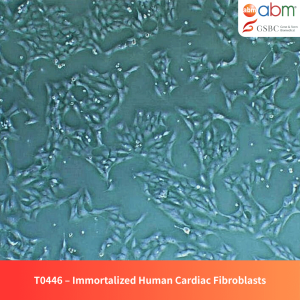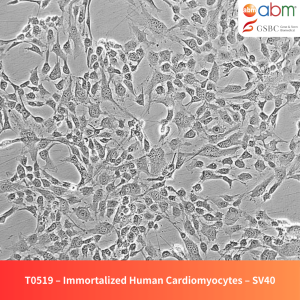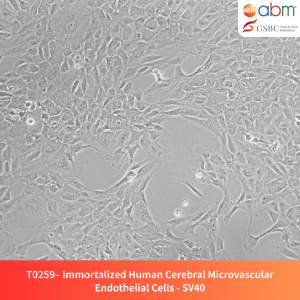Product Details
- Catalog Number: T0783
- Unit Size: 1 x 10⁶ cells / 1.0 mL
- Species: Human (Homo sapiens)
- Tissue: Brain
- Donor Information: Not disclosed
- Cell Type: Immortalized astrocytes
- Growth Properties: Adherent, spindle-shaped
- Biosafety Level: BSL-2
- Storage: Vapor phase of liquid nitrogen or below -130°C
- Shipping: Shipped on dry ice
- Format: Cryopreserved frozen cells
Overview
Immortalized Human Adult Brain Astrocytes (AST-1) provide a robust platform for investigating astrocyte functions in neurobiology. These cells were immortalized using hTERT and SV40 genes, allowing extended culture periods and enhanced research reproducibility. AST-1 cells are ideal for studies in neurodegeneration, brain injury response, and glial cell signaling, making them an essential tool for neuroscience research.
Key Features and Benefits
- Long-Term Viability: Immortalized for extended culture duration without senescence.
- Reproducibility: Provides consistent results across multiple experiments.
- Ideal for Neurobiology Research: Supports studies on astrocyte-neuron interactions, neuroinflammation, and neurodegeneration.
- Optimized Growth Conditions: Adapted to specific media and extracellular matrices for enhanced viability.
- Adherent Growth Properties: Facilitates easy handling and maintenance in culture.
Culture & Handling Guidelines
Recommended Culture Conditions
- Coating: Use PriCoat™ T25 Flasks (G299) or Applied Cell Extracellular Matrix (G422) for optimal adhesion.
- Growth Medium: PriGrow IV (TM004) supplemented with:
- 10% Fetal Bovine Serum (FBS)
- 10 ng/mL Human EGF (Z100139)
- 10 ng/mL Human HGF (Z102775)
- 10 ng/mL Human IGF-1 (Z100385)
- 1% Penicillin/Streptomycin (G255)
- Incubation Conditions: Maintain at 37°C in a humidified atmosphere with 5% CO₂.
- Seeding Density: 20,000 – 40,000 cells/cm²
- Doubling Time: ~5 days
Thawing Protocol
- Quickly thaw cells in a 37°C water bath (maximum 2 minutes). Keep the vial cap above water level to avoid contamination.
- Decontaminate the vial by spraying with 70% ethanol and transfer to a biosafety cabinet.
- Add thawed cells to a sterile 15mL conical tube containing 5mL of pre-warmed complete growth medium.
- Centrifuge at 125xg for 5-7 minutes.
- Aspirate the supernatant, gently resuspend the cell pellet in fresh complete medium, and seed into a pre-coated T25 flask.
- Incubate under recommended conditions and allow cells to recover before passaging.
Subculturing Guidelines
- Aspirate the old medium and rinse cells with PBS.
- Add 2-3 mL of pre-warmed 0.25% Trypsin-EDTA and incubate at 37°C until cells detach (~2-10 minutes).
- Neutralize trypsin by adding an equal volume of complete medium.
- Centrifuge at 125xg for 5 minutes, aspirate the supernatant, and resuspend the pellet in fresh growth medium.
- Seed cells at the appropriate density into new culture vessels.
- Incubate under recommended conditions and monitor for confluency.
Cryopreservation Guidelines
- Cryopreservation Medium: Use Cryopreservation Medium (TM024) or complete growth medium supplemented with 10% DMSO.
- Freezing Protocol: Freeze at a controlled rate (-1°C per minute) before transferring to liquid nitrogen storage.
STR Profiling (Short Tandem Repeat Analysis)
- D5S818: 11,13
- D13S317: 8,8
- D7S820: 8,10
- D16S539: 9,13
- VWA: 17,17
- TH01: 6,6
- AMEL: X
- TPOX: 8,12
- CSF1PO: 10,10
- D21S11: 30,31.2
Related Products
- Recombinant Human MANF (E. coli) – Z102065, Z102069
- Recombinant Human GDNF (E. coli) – Z101055, Z101059
- Recombinant Human BDNF – Z100065
- Recombinant Human IL-33 (E. coli) – Z100535
Disclaimer
- This product is intended for research use only and is not for therapeutic, diagnostic, or clinical use in humans or animals.
- The buyer assumes all responsibility for ensuring that this product meets the requirements of their intended applications and culture conditions.
- All test parameters are derived from standard in-house procedures; variations in experimental conditions may yield different results.
- Any material resulting from the use of this product should be properly cited in scientific publications.
- This product is subject to a Material Transfer Agreement (MTA). Contact technical support for licensing inquiries.





